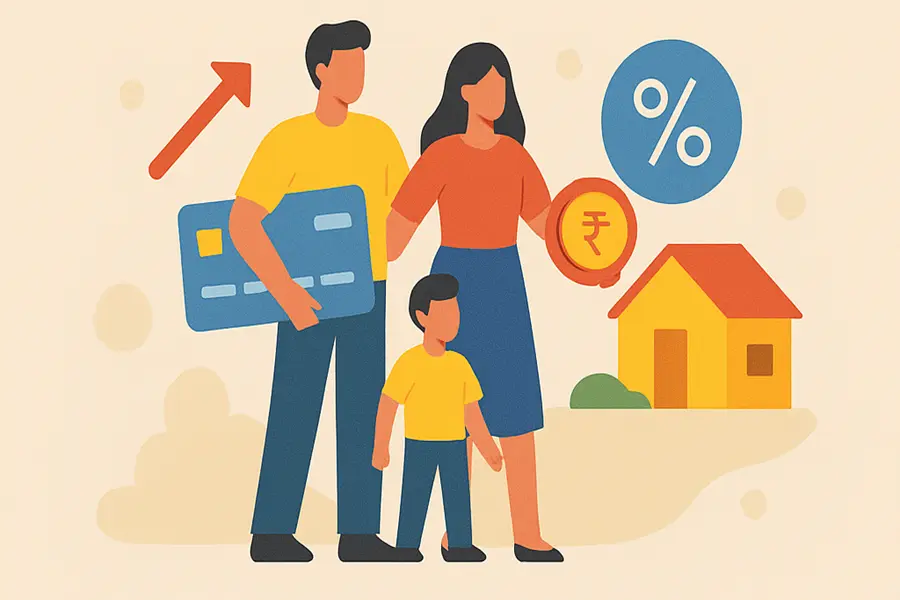Rising household debt has become a pressing challenge for India’s middle class, where aspirations often outpace incomes.
From home loans and education expenses to credit card bills and personal borrowing, families are juggling multiple financial commitments. While debt can sometimes fuel growth, unmanaged borrowing quickly turns into a burden that limits savings and future security.
Understanding why debt is rising and how to manage it wisely is crucial for financial stability.
In this article, we will explore the best strategies for debt management in middle‑class India, offering practical, actionable steps to reduce stress, build resilience, and secure long‑term financial wellbeing.

Rising Household Debt in Middle-Class India: Best strategies for Debt management
India’s middle class is expanding faster than ever, driven by rising incomes, urban lifestyles, and growing aspirations.
From owning a dream home to upgrading smartphones every year, this section of society is fueling the nation’s consumer boom. But behind the glitter of progress lies a silent burden — household debt.
In simple terms, household debt means the total money families owe — through home loans, car EMIs, credit cards, or personal loans.
While borrowing helps people achieve goals earlier, poor planning and overspending often turn this convenience into a financial trap.
Over the past few years, India has seen a surge in EMIs, credit card spending, and easy consumer loans. The “buy now, pay later” culture has made borrowing effortless — and debt harder to escape.
From EMIs to credit cards, middle-class families are drowning in debt faster than they realize. Understanding why this is happening — and how to manage it — is crucial for financial stability in modern India.
Understanding the Debt Trap
A debt trap is a situation where a person borrows money to repay existing loans — and ends up sinking deeper into financial trouble. It starts innocently: a credit card bill here, a personal loan there.
But when repayments pile up and incomes can’t keep pace, families find themselves caught in a cycle where each new loan only patches up the previous one.
In today’s India, easy credit is one of the biggest triggers. Banks, fintech apps, and “buy now, pay later” offers make borrowing effortless — often without helping users understand the long-term costs.
Lifestyle inflation adds to the problem: upgrading gadgets, cars, or homes to match peers becomes a social norm. What was once a luxury is now seen as a necessity, even if it means stretching monthly budgets.
Another key reason is lack of financial literacy. Many middle-class earners don’t fully grasp how compound interest or late fees can double their dues over time.
Unexpected emergencies — like medical bills or education expenses — also push families to take high-interest loans, further tightening the financial noose.
Consider this common scenario: a salaried employee juggling multiple EMIs, swiping credit cards to cover daily needs, and then taking a personal loan to clear card dues. On paper, it looks manageable. In reality, it’s the start of a downward spiral — one that erodes both financial and mental peace.
Recognizing these warning signs early is the first step toward breaking free from the debt trap and regaining control of one’s finances.
The Numbers Behind the Problem
The scale of India’s household debt is no longer small — the data shows it’s ballooning fast, especially among middle-class borrowers. According to the RBI’s Financial Stability Report, India’s household debt reached 41.9% of GDP as of December 2024.
Plus per capita debt for individual borrowers has risen sharply: from ₹3.9 lakh in March 2023 to approximately ₹4.8 lakh by March 2025.
More than half of that debt is non-housing retail loans — which include credit card dues, personal loans, consumer durable financing, etc. These now make up about 54.9% of total household debt.
At the same time, such loans correspond to 25.7% of disposable income, meaning a quarter of what households earn is tied up in servicing unsecured or consumption-oriented borrowings.
Another striking number: salaried Indians are dedicating more than 33% of their monthly income toward EMIs. That means one-third of take-home income is locked into paying off loans — before discretionary spending, emergencies, or savings.
While the above figures are nationwide, there are urban vs rural differences too. Urban households tend to borrow more frequently through formal channels, have larger EMIs, and often carry more unsecured debt like credit-card balances or digital lending.
Rural borrowing sometimes depends more on informal credit, and has different risk profiles. (Though exact rural-vs-urban splits vary by region and survey.)
Also worth noting: “Buy Now, Pay Later” (BNPL) and digital-credit fintech flows are growing quickly. While exact pan-India statistics for BNPL are still emerging, its rise adds another layer to consumption-oriented debt — often smaller per transaction, but more impulsive and less regulated than traditional bank loans.
These numbers show that debt isn’t just rising — its share of income is increasing, and much of it is being used for consumption rather than asset investment.
Types of Household Debts Affecting Middle-Class Indians
For India’s middle class, debt comes in many forms — some necessary, others risky. Understanding each type helps families make smarter financial decisions and maintain a balanced cash flow.
1. Secured Loans
These are loans backed by collateral — like home loans, car loans, or gold loans. They usually come with lower interest rates and longer repayment periods. However, the EMIs are often large and span several years, eating into monthly savings. Missing payments can also lead to loss of assets. For many middle-class families, home EMIs can take up 30–40% of monthly income, leaving little room for emergencies or investments.
2. Unsecured Loans
This category includes credit cards, personal loans, and BNPL (Buy Now Pay Later) services. Since there’s no collateral, the interest rates are much higher — sometimes exceeding 30% annually. They offer quick access to funds but can quickly turn into a trap if repayments are delayed or only minimum dues are paid. Unsecured debts directly strain cash flow, reducing disposable income month after month.
3. Hidden Debts
These are the informal borrowings often overlooked — such as taking advances from relatives, friends, or using short-term credit from digital lending apps. While they may seem small, these debts accumulate silently. Many digital credit apps charge hidden fees and penalties that worsen financial stress.
These three forms of debt create a constant tug-of-war on the middle-class wallet. Managing them smartly — by prioritizing repayments and tracking expenses — is key to maintaining a healthy financial balance and avoiding the modern debt trap.
Signs You Might Be in a Debt Trap
Falling into a debt trap doesn’t happen overnight — it creeps in slowly, often disguised as “manageable” EMIs or harmless credit card bills. Recognizing the early warning signs is the first step toward regaining control over your finances.
Here are the key indicators that you might already be caught in the cycle:
- Struggling to pay multiple EMIs: If your salary vanishes within days of arrival because several EMIs are due, your debt-to-income ratio may be dangerously high. Ideally, EMIs should not exceed 30–35% of your monthly income.
- Using one loan to pay another: Taking a new personal loan or cash advance to clear an old one is a red flag. It only postpones the problem while increasing your total debt burden.
- Missing due dates or paying only the minimum on credit cards: Paying the “minimum amount due” might seem convenient, but it leads to skyrocketing interest charges — often above 30% annually — and keeps you trapped in perpetual repayment.
- Feeling anxiety or guilt around money: Constant stress about bills, avoiding financial discussions, or losing sleep over payments are emotional signs that your debt is controlling you, not the other way around.
When these symptoms appear together, it’s time to pause and reassess your financial habits. Review your expenses, track your debts, and seek guidance from financial experts if needed.
Remember: acknowledging the problem isn’t a failure — it’s the first step toward freedom from the debt trap and rebuilding long-term financial stability.
Smart Strategies for Debt Management
Managing debt isn’t about cutting all spending — it’s about making smarter choices. By organizing your finances and adopting proven repayment methods, you can regain control and move steadily toward financial freedom.
a. Create a Realistic Budget
Start by tracking every rupee — income, expenses, and hidden costs. Use budgeting apps or a simple spreadsheet to see where your money goes. Follow the 50-30-20 rule: 50% for needs, 30% for wants, and 20% for savings or debt repayment. A clear budget exposes wasteful spending and helps free up cash for faster debt reduction.
b. Use the Debt Snowball or Avalanche Method
The snowball method focuses on clearing the smallest debt first to build motivation. The avalanche method targets the highest-interest debt for faster savings. Example: If you owe ₹10,000 on a credit card and ₹50,000 on a personal loan, paying off the card first (snowball) boosts morale, while tackling the loan first (avalanche) saves interest.
c. Prioritize High-Interest Debts
Focus on clearing credit cards and personal loans before low-interest ones like home loans. High-interest debts grow fastest, so paying them off early prevents unnecessary interest buildup and reduces stress.
d. Negotiate with Lenders
If repayment feels overwhelming, talk to your lender. Banks often offer loan restructuring or lower interest rates for consistent borrowers. A polite, proactive approach can ease your monthly burden.
e. Avoid New Borrowing
Pause new EMIs and resist impulse purchases. Each new loan delays your financial recovery. Use cash or debit cards instead.
f. Build an Emergency Fund
Save at least three to six months’ expenses. This safety net prevents new borrowing during job loss or emergencies, protecting your financial stability long-term.
Professional Help and Financial Counseling
Sometimes, despite your best efforts, managing multiple debts alone can feel overwhelming. That’s when seeking professional help becomes a smart and necessary move.
A certified financial planner (CFP) or debt counselor can objectively assess your finances, identify problem areas, and create a practical repayment plan tailored to your income and lifestyle.
You should consider professional guidance if you’re constantly missing EMIs, using one loan to pay another, or unsure where your money goes each month.
Expert counselors can negotiate with lenders, help consolidate debts, and teach financial discipline — skills that last a lifetime.
In India, the Reserve Bank of India (RBI) has approved credible institutions such as Credit Counselling Trusts (CCTs) and DRCCs (Debt Recovery Counselling Centres) to assist individuals facing debt stress.
Some recognized agencies include Abhay Credit Counselling Centre (Bank of India) and Disha Financial Counselling (ICICI Foundation).
Seeking help isn’t a weakness — it’s a responsible step toward financial recovery and long-term peace of mind.
Government and Institutional Support
The Indian government and financial regulators have introduced several initiatives to promote financial literacy and protect consumers from debt stress.
The Reserve Bank of India (RBI) regularly conducts awareness campaigns under its Financial Literacy Week, educating citizens about budgeting, responsible borrowing, and digital safety.
Similarly, the Securities and Exchange Board of India (SEBI) promotes financial education through schools, colleges, and community programs, empowering individuals to make informed money decisions.
For those already struggling with repayment, debt resolution schemes and banking reforms — such as one-time settlement (OTS) options and restructuring facilities — offer breathing space to reorganize finances without legal stress.
Another vital aspect is credit score awareness. Monitoring your CIBIL score helps maintain good credit health, ensuring easier access to loans at lower interest rates. A strong score above 750 reflects financial discipline and boosts your credibility with lenders — a simple but powerful tool for long-term financial stability.
Conclusion
Debt, in itself, isn’t the enemy — it’s a tool. When used wisely, it can help you buy a home, fund education, or build a better life.
The real problem begins when borrowing becomes impulsive, unplanned, or emotionally driven.
Learning to manage debt is not just about repayment — it’s about building a healthier relationship with money.
By tracking expenses, setting priorities, and staying informed, every middle-class family can break free from the stress of financial uncertainty.
Awareness of interest rates, credit scores, and budgeting habits can turn debt from a burden into a stepping stone toward growth.
Remember, financial security isn’t achieved overnight; it’s built through small, consistent actions — saving before spending, borrowing only when necessary, and staying disciplined.
Financial freedom begins when you take control of your debts — not when you escape them.
Take charge, stay informed, and let every rupee you earn work for your future, not against it.





